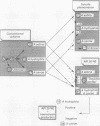Abstract
AIMS: To establish the suitability of currently available phenotypic methods for speciation of clinical Aeromonas isolates in diagnostic microbiology laboratories. METHODS: Using 62 Aeromonas spp, three schemes based on biochemical reactions were compared: a series of conventional tests; a system based on the suicide phenomenon, comprising two tubes in total; and a commercially available test, API 20 NE, augmented with a plate assay for beta haemolysin production. The whole cell and outer membrane protein (OMP) profiles of strains were examined by sodium dodecyl sulphate polyacrylamide gel electrophoresis (SDS PAGE), according to the results of the above schemes, to determine the intra-species homogeneity. RESULTS: Ninety per cent of strains were identified satisfactorily according to conventional criteria. For these strains, agreement was obtained using the suicide phenomenon and API schemes in 93% and 88% of cases, respectively. The three schemes concurred for 82% of strains. Whole cell protein profiles were unsuitable for comparing strains within a species. However, OMP patterns were similar for 89% of A caviae and 63% of A hydrophila. CONCLUSION: Phenospeciation of clinical Aeromonas isolates by the scheme based on the suicide phenomenon is simple to perform and accurate, and suitable for use in the diagnostic laboratory. OMP profiles are potentially useful for confirming the identity of A caviae and most A hydrophila, but not A sobria.
Full text
PDF




Images in this article
Selected References
These references are in PubMed. This may not be the complete list of references from this article.
- Altwegg M., Steigerwalt A. G., Altwegg-Bissig R., Lüthy-Hottenstein J., Brenner D. J. Biochemical identification of Aeromonas genospecies isolated from humans. J Clin Microbiol. 1990 Feb;28(2):258–264. doi: 10.1128/jcm.28.2.258-264.1990. [DOI] [PMC free article] [PubMed] [Google Scholar]
- Carnahan A. M., Behram S., Joseph S. W. Aerokey II: a flexible key for identifying clinical Aeromonas species. J Clin Microbiol. 1991 Dec;29(12):2843–2849. doi: 10.1128/jcm.29.12.2843-2849.1991. [DOI] [PMC free article] [PubMed] [Google Scholar]
- Carnahan A. M., Chakraborty T., Fanning G. R., Verma D., Ali A., Janda J. M., Joseph S. W. Aeromonas trota sp. nov., an ampicillin-susceptible species isolated from clinical specimens. J Clin Microbiol. 1991 Jun;29(6):1206–1210. doi: 10.1128/jcm.29.6.1206-1210.1991. [DOI] [PMC free article] [PubMed] [Google Scholar]
- Janda J. M., Duffey P. S. Mesophilic aeromonads in human disease: current taxonomy, laboratory identification, and infectious disease spectrum. Rev Infect Dis. 1988 Sep-Oct;10(5):980–997. doi: 10.1093/clinids/10.5.980. [DOI] [PubMed] [Google Scholar]
- Janda J. M. Recent advances in the study of the taxonomy, pathogenicity, and infectious syndromes associated with the genus Aeromonas. Clin Microbiol Rev. 1991 Oct;4(4):397–410. doi: 10.1128/cmr.4.4.397. [DOI] [PMC free article] [PubMed] [Google Scholar]
- Kokka R. P., Vedros N. A., Janda J. M. Electrophoretic analysis of the surface components of autoagglutinating surface array protein-positive and surface array protein-negative Aeromonas hydrophila and Aeromonas sobria. J Clin Microbiol. 1990 Oct;28(10):2240–2247. doi: 10.1128/jcm.28.10.2240-2247.1990. [DOI] [PMC free article] [PubMed] [Google Scholar]
- Kuijper E. J., Steigerwalt A. G., Schoenmakers B. S., Peeters M. F., Zanen H. C., Brenner D. J. Phenotypic characterization and DNA relatedness in human fecal isolates of Aeromonas spp. J Clin Microbiol. 1989 Jan;27(1):132–138. doi: 10.1128/jcm.27.1.132-138.1989. [DOI] [PMC free article] [PubMed] [Google Scholar]
- Kuijper E. J., Steigerwalt A. G., Schoenmakers B. S., Peeters M. F., Zanen H. C., Brenner D. J. Phenotypic characterization and DNA relatedness in human fecal isolates of Aeromonas spp. J Clin Microbiol. 1989 Jan;27(1):132–138. doi: 10.1128/jcm.27.1.132-138.1989. [DOI] [PMC free article] [PubMed] [Google Scholar]
- Kuijper E. J., van Alphen L., Leenders E., Zanen H. C. Typing of Aeromonas strains by DNA restriction endonuclease analysis and polyacrylamide gel electrophoresis of cell envelopes. J Clin Microbiol. 1989 Jun;27(6):1280–1285. doi: 10.1128/jcm.27.6.1280-1285.1989. [DOI] [PMC free article] [PubMed] [Google Scholar]
- Lugtenberg B., Meijers J., Peters R., van der Hoek P., van Alphen L. Electrophoretic resolution of the "major outer membrane protein" of Escherichia coli K12 into four bands. FEBS Lett. 1975 Oct 15;58(1):254–258. doi: 10.1016/0014-5793(75)80272-9. [DOI] [PubMed] [Google Scholar]
- Millership S. E., Barer M. R., Tabaqchali S. Toxin production by Aeromonas spp. from different sources. J Med Microbiol. 1986 Dec;22(4):311–314. doi: 10.1099/00222615-22-4-311. [DOI] [PubMed] [Google Scholar]
- Namdari H., Bottone E. J. Suicide phenomenon in mesophilic aeromonads as a basis for species identification. J Clin Microbiol. 1989 Apr;27(4):788–789. doi: 10.1128/jcm.27.4.788-789.1989. [DOI] [PMC free article] [PubMed] [Google Scholar]
- Pazzaglia G., Sack R. B., Salazar E., Yi A., Chea E., Leon-Barua R., Guerrero C. E., Palomino J. High frequency of coinfecting enteropathogens in Aeromonas-associated diarrhea of hospitalized Peruvian infants. J Clin Microbiol. 1991 Jun;29(6):1151–1156. doi: 10.1128/jcm.29.6.1151-1156.1991. [DOI] [PMC free article] [PubMed] [Google Scholar]
- Popoff M., Véron M. A taxonomic study of the Aeromonas hydrophila-Aeromonas punctata group. J Gen Microbiol. 1976 May;94(1):11–22. doi: 10.1099/00221287-94-1-11. [DOI] [PubMed] [Google Scholar]
- Statner B., Jones M. J., George W. L. Effect of incubation temperature on growth and soluble protein profiles of motile Aeromonas strains. J Clin Microbiol. 1988 Feb;26(2):392–393. doi: 10.1128/jcm.26.2.392-393.1988. [DOI] [PMC free article] [PubMed] [Google Scholar]
- Stephenson J. R., Millership S. E., Tabaqchali S. Typing of Aeromonas species by polyacrylamide-gel electrophoresis of radiolabelled cell proteins. J Med Microbiol. 1987 Sep;24(2):113–118. doi: 10.1099/00222615-24-2-113. [DOI] [PubMed] [Google Scholar]
- Watson I. M., Robinson J. O., Burke V., Gracey M. Invasiveness of Aeromonas spp. in relation to biotype, virulence factors, and clinical features. J Clin Microbiol. 1985 Jul;22(1):48–51. doi: 10.1128/jcm.22.1.48-51.1985. [DOI] [PMC free article] [PubMed] [Google Scholar]
- Wilcox M. H., Cook A. M., Eley A., Spencer R. C. Aeromonas spp as a potential cause of diarrhoea in children. J Clin Pathol. 1992 Nov;45(11):959–963. doi: 10.1136/jcp.45.11.959. [DOI] [PMC free article] [PubMed] [Google Scholar]







